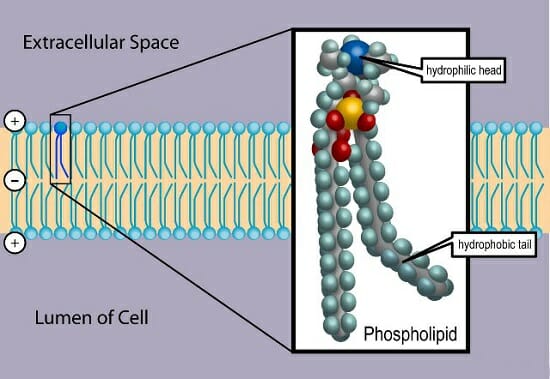3 Which Best Describes the Structure of a Phospholipid
A glycerol molecule between two fatty acids. A lipid molecule with a polar head and a tail Phospholipid and is a class of lipids.

Phospholipids Introduction To Chemistry
The proportion of constituency of plasma membrane ie the carbohydrates lipids and proteins vary.

. Which statement best explains the effect on membrane permeability of cholesterol andor temperature. Phospholipids consist of a glycerol molecule two fatty acids and a phosphate group that is modified by an alcohol. A lipid molecule with polar head an tail d.
Quizzes tests revision. A polar head and a non polar tail B. The phospholipid is an amphiphatic molecule having hydrophobic tail and hydrophilic head.
It is composed of phospholipid bilayer structure with embedded proteins. As portrayed in the diagrammatic illustration above the glycerol molecule and the phosphate group makes up the hydrophilic head or the water-loving part of the phospholipid. A glycerol molecule between two fatty acids c.
They are self-marking questions so you can click on check to see whether you have the answer correct. Which of the following best described the make-up of a phospholipid. A polar head and a nonpolar tail.
A non polar molecule attached to fatty acid. The fatty acid chains are the uncharged nonpolar tails which are hydrophobic. The phospholipid bilayer is made of two layers of phospholipids.
When phospholipids are added to an aqueous environment consisting mostly of water the phospholipid molecules will spontaneously assemble into a phospholipid bilayer where the layers are held together by weak attractive forces between molecules. A lipid molecule with a polar head and a tail Phospholipid and is a class of lipids. The fatty acid chains are uncharged and non-polar while the phosphate head is polar and negatively charged.
The two layers are arranged so that the tails face inward and the. A phosphate molecule joined to a fatty acid. Which word best describes the structure of the cell membrane.
The hydrophobic tails each containing either a saturated or an unsaturated fatty acid are long hydrocarbon chains. The structure of phospholipid is described as having a hydrophilic head and a hydrophobic tail. Phospholipid Molecule Structure Source.
What best describes the structure of a phospholipid. It imparts a fluid character on the membrane. The hydrophobic tail of the phospholipid molecule is composed of two fatty acid chains.
Which best describes the structure of a phospholipid. A nonpolar head and tail. Answer choices The head is polarhydrophilic.
It is the main part of cell membranes. The phospholipid molecules forms micelles when placed in water. A non polar molecule attached to fatty acid b.
This is called the amphiphilic character of phospholipids. Each question has a helpful note written by an examiner. The tail is non-polarhydrophobic.
It is the main part of cell membranes. The membrane proteins help in transportation of water ions and solute across the membrane and thus provide semi permeability to the membrane. Because the interior of the phospholipid bilayer is occupied by hydrophobic fatty acid chains the membrane is impermeable to water-soluble molecules including ions and most biological molecules.
What is a phospholipid composed of. Each phospholipid has a hydrophilic head and a hydrophobic tail. Which best describes the structure of a phospholipid.
This is a quiz of multiple choice style questions about the structure of membranes topic 13. A nonpolar head and a polar tail C. The model describes plasma membrane structure as a mosaic of components which includes proteins cholesterol phospholipids and carbohydrates.
Plasma membrane is the outer covering of all the cells but only in a plant cell it is present below the cell wall. A polar head and tail D. When the phospholipid molecules are joined by other lipids and integral proteins the surface can.
Which statement most accurately describes the relationship between the permeability and fluidity. These structures are often seen in nature as cell and organelle membranes. Thickness of the membrane is in the range of 5-10nm.
The hydrophilic head group consists of a phosphate-containing group attached to a glycerol molecule. A phospholipid is an amphiphilic molecule consisting of a polar head region a unit of glycerol and two or more non-polar fatty acid tails typically found in a cell membrane. The hydrophilic head of the phospholipid molecule is composed of a phosphate group and a glycerol backbone.
Marine phospholipids typically have omega-3 fatty acids EPA and DHA integrated as part of the phospholipid molecule. Adding cholesterol reduces permeability because its steroid rings fill gaps in the hydrophobic membrane interior. A lipid molecule with a polar head and a tail a nonpolar molecule attached to a fatty acid a phosphate molecule joined to a fatty acid a glycerol molecule between two fatty acid chains.
Since the tails are hydrophobic they face the inside away from the water and meet in the inner. Are amphipathic double-charged molecules composed of one glycerol molecule one phosphate group and two fatty acid units. Da phosphate molecule joined to a fatty acid.
A lipid molecule with polar head an tail. A bilayer of phospholipid molecules forms a plasma membrane. Phospholipids also known as phosphatides are a class of lipids whose molecule has a hydrophilic head containing a phosphate group and two hydrophobic tails derived from fatty acids joined by an alcohol residue usually a glycerol molecule.
The phosphate group is the negatively-charged polar head which is hydrophilic. First the structure of phospholipids is responsible for the basic function of membranes as barriers between two aqueous compartments. Figure 322 This phospholipid molecule is composed of a hydrophilic head and two hydrophobic tails.
The phospholipid is composed of a glycerol molecule and tow fatty acid chains. What best describes the structure of a phospholipid.

Phospholipids Biology For Majors I
Phospholipids Introduction To Chemistry

Phospholipid Definition Structure Function Biology Dictionary
0 Response to "3 Which Best Describes the Structure of a Phospholipid"
Post a Comment